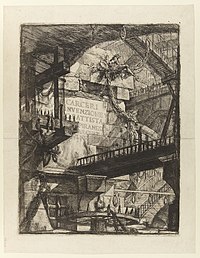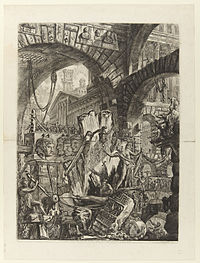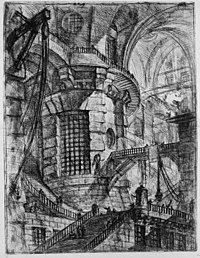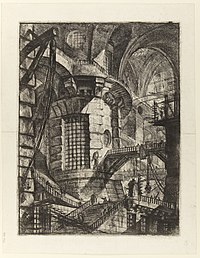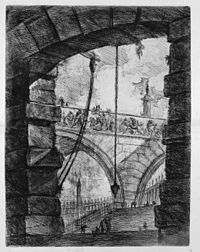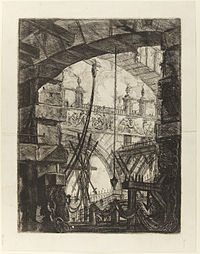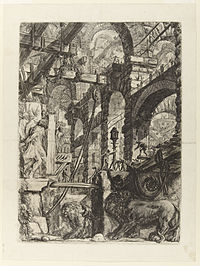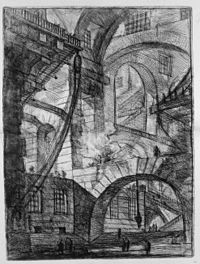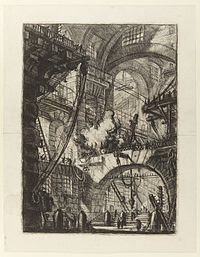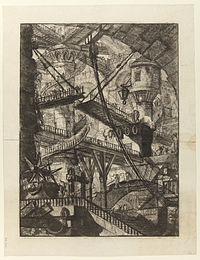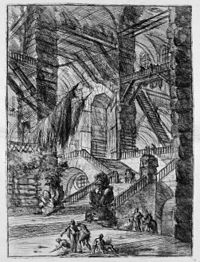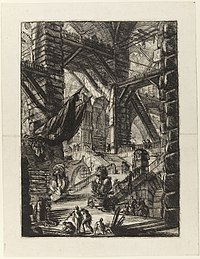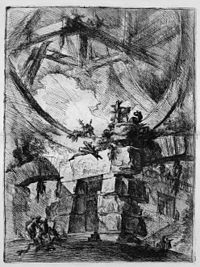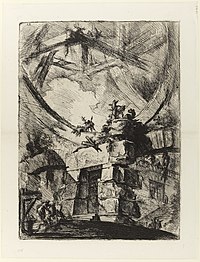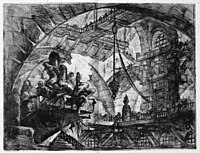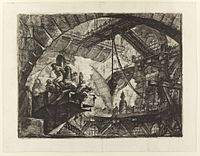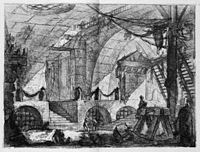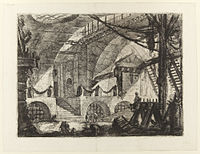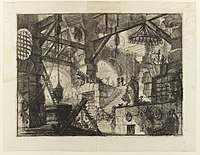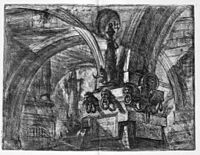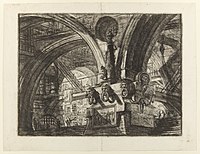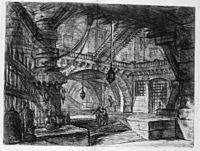
Maurits Cornelis Escher was a Dutch graphic artist who made mathematically inspired woodcuts, lithographs, and mezzotints. Despite wide popular interest, Escher was for most of his life neglected in the art world, even in his native Netherlands. He was 70 before a retrospective exhibition was held. In the late twentieth century, he became more widely appreciated, and in the twenty-first century he has been celebrated in exhibitions around the world.

Giovanni BattistaPiranesi was an Italian Classical archaeologist, architect, and artist, famous for his etchings of Rome and of fictitious and atmospheric "prisons". He was the father of Francesco Piranesi and Laura Piranesi.

Giovanni Battista Tiepolo, also known as GiambattistaTiepolo, was an Italian painter and printmaker from the Republic of Venice who painted in the Rococo style, considered an important member of the 18th-century Venetian school. He was prolific, and worked not only in Italy, but also in Germany and Spain.
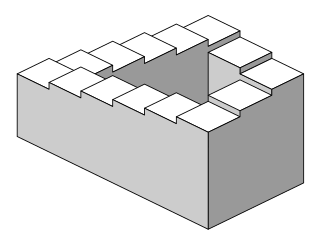
The Penrose stairs or Penrose steps, also dubbed the impossible staircase, is an impossible object created by Oscar Reutersvärd in 1937 and later independently made popular by Lionel Penrose and his son Roger Penrose. A variation on the Penrose triangle, it is a two-dimensional depiction of a staircase in which the stairs make four 90-degree turns as they ascend or descend yet form a continuous loop, so that a person could climb them forever and never get any higher. This is clearly impossible in three-dimensional Euclidean geometry.
Visionary architecture is the name given to architecture which exists only on paper or which has visionary qualities. While the term 'visionary' suggests the idea of an idealistic, impractical or Utopian notion, it also depicts a mental picture produced by the imagination. These architectural drawings on paper allow insight of the unusual perception of the worlds that are impossible to visit everyday, except through the visual dramatization of the designed, imaginative environment. There are also two meanings that are derived from both terms 'imagination' and 'imaginary,' meaning unrealistic and impossible, and the other the ability to deal creatively with an unseen reality. A significant precedent that adheres to the concept of visionary architecture is the 18th century architect Giovanni Piranesi, who also had to think twice about the difference in meaning of the two terms. The titles of his well-known prison etching works had two versions. The first was 'imaginary prisons,' and the final as 'prisons of the imagination.'
Inspired by Bach, a part of Sony Classical celebrates Bach, presented the contemporary cellist Yo-Yo Ma performing the six Suites for Unaccompanied Cello by Johann Sebastian Bach, in a series of six films, each showing a collaboration with artists from different disciplines.
Giuseppe Vasi was an Italian engraver and architect, best known for his vedute.
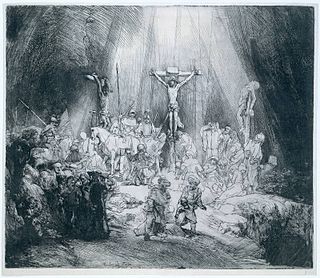
An old master print is a work of art produced by a printing process within the Western tradition. The term remains current in the art trade, and there is no easy alternative in English to distinguish the works of "fine art" produced in printmaking from the vast range of decorative, utilitarian and popular prints that grew rapidly alongside the artistic print from the 15th century onwards. Fifteenth-century prints are sufficiently rare that they are classed as old master prints even if they are of crude or merely workmanlike artistic quality. A date of about 1830 is usually taken as marking the end of the period whose prints are covered by this term.

Francesco Piranesi was an Italian engraver, etcher and architect. He was the son of the more famous Giovanni Battista Piranesi and continued his series of engravings representing monuments and ancient temples. He worked for a long period in France, where he lived during the French Revolution.

Étude Op. 10, No. 1 in C major, known as the Waterfall étude, is a study for solo piano composed by Frédéric Chopin in 1829. It was first published in 1833 in France, Germany, and England as the first piece of his Études Op. 10. This study in reach and arpeggios focuses on stretching the fingers of the right hand. The American music critic James Huneker (1857–1921) compared the "hypnotic charm" that these "dizzy acclivities and descents exercise for eye as well as ear" to the frightening staircases in Giovanni Battista Piranesi's prints of the Carceri d'invenzione. Virtuoso pianist Vladimir Horowitz, who refused to perform this étude in public, said, "For me, the most difficult one of all is the C Major, the first one, Op. 10, No. 1."

Hercules Pieterszoon Seghers or Segers was a Dutch painter and printmaker of the Dutch Golden Age. He has been called "the most inspired, experimental and original landscapist" of his period and an even more innovative printmaker.
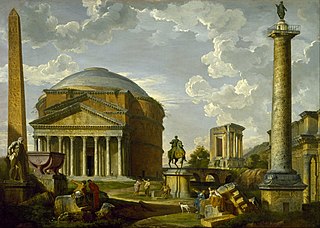
In painting, a capriccio means an architectural fantasy, placing together buildings, archaeological ruins and other architectural elements in fictional and often fantastical combinations. These paintings may also include staffage (figures). Capriccio falls under the more general term of landscape painting. The term is also used for other artworks with an element of fantasy. This style of painting was introduced in the Renaissance and continued into the Baroque.
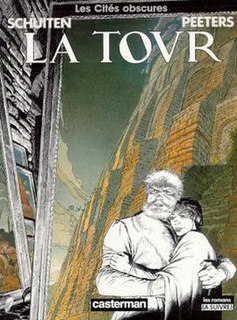
La Tour is a graphic novel by Belgian comic artists François Schuiten and Benoît Peeters, the third volume of their ongoing Les Cités Obscures series. It was first published in serialized form in the Franco-Belgian comics magazine À Suivre (#96-106), and as a complete volume first in 1987 by Casterman. In English, it was published as The Tower in 1993 by NBM Publishing, and as The Tower in 2022 in a new translation by IDW Publishing.
Sarah F. Maclaren is an Anglo-Italian cultural theorist, sociologist and anthropologist. She is also an expert of Cultural Studies, History of ideas, Aesthetics, Rhetoric, and a cultural and academic organizer.
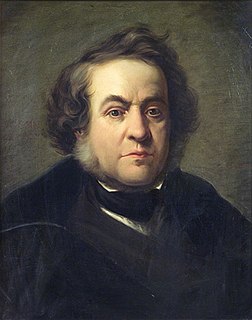
Luigi Rossini (1790–1857) was an Italian artist, best known for his etchings of ancient Roman architecture.
Emily Allchurch is a British artist who is known for using digital photography and lightbox art to create new works based on masterpieces of world art.
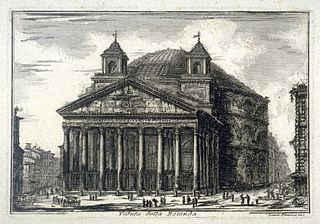
Laura Piranesi (1754–1789) was an Italian etcher working in Rome towards the end of the 18th century. She was an active participant in her family's print workshop, run by her father Giovanni Battista Piranesi, an Italian artist, etcher, and antiquarian. Participating in the veduta genre, Laura's prints consist of stylized views of Roman architecture and ruins that aim to capture the spirit of the city through landscapes. Vedute and architectural prints were particularly popular among travelers participating in the Grand Tour, and as Laura lived and worked during the height of the Grand Tour, her prints catered to the souvenir market. Her use of chiaroscuro and free-flowing lines reflect the rising popularity of Romanticism, which prioritizes emotion over accuracy.

Lothar Osterburg is a German-born, New York-based artist and master printer in intaglio, who works in sculpture, photography, printmaking and video. He is best known for photogravures featuring rough small-scale models of rustic structures, water and air vessels, and imaginary cities, staged in evocative settings and photographed to appear life-size to disorienting, mysterious or whimsical effect. New York Times critic Grace Glueck writes that Osterburg's rich-toned, retro prints "conjur[e] up monumental phenomena by minimal means"; Judy Pfaff describes his work as thick with film noir–like atmosphere, warmth, reverie, drama and timelessness.

Piranesi is a fantasy novel by English author Susanna Clarke, published by Bloomsbury Publishing in 2020. It is Clarke's second novel, following her debut Jonathan Strange & Mr Norrell (2004), published sixteen years earlier. Piranesi won the 2021 Women's Prize for Fiction.
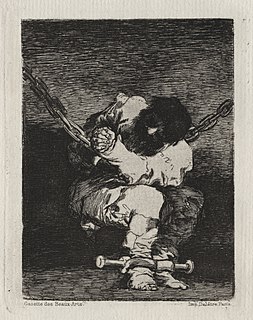
The Prisoners is a series of three etchings by Francisco de Goya, depicting imprisoned men with indistinct faces, bound with leg irons in stress positions. The prints are not dated, but they are believed to have been made between 1810 and 1815, around the time Goya started his print series The Disasters of War. Political considerations made it impossible for Goya to publish the prints during his lifetime.

